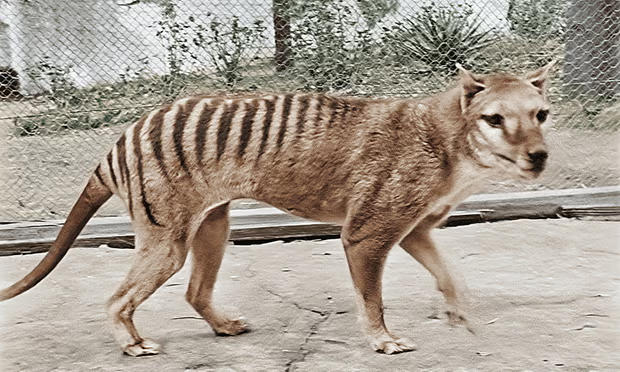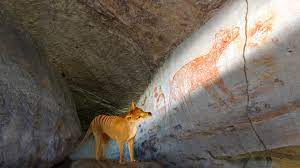Mainland Forgotten Fauna Part 16: A more complete story of the Thylacine and placing our missing apex predators on the mainland into context
It has been a while since I wrote an instalment for our blog series on forgotten fauna, but a number of things I have come across lately got me thinking again about this topic, so let’s dive back in again!
Before I share those interesting links however, you might like to revisit Part 8 of this series of blogs, where I talked in detail about the concept of shifting baselines. This will help to remind you about both how and why it is so easy for us humans to overlook the true underlying nature and history of ecosystems across this vast continent. This is really important, because it has profound implications for the way that we now conceive of and set-up ecological restoration projects and their goals.
More than simply putting back individual missing species as standalone environmental ‘ingredients’, restoration projects are often about initiating missing ecological processes and/or functions, particularly those that led to the demise of species that have declined or become absent. Apex predators remain a fascinating topic for ecologists, because they might seem like a single ecological ingredient, but their position at the top of the food web means they can exert a wide range of both direct and indirect influences, cascading through multiple levels of an ecosystem. To learn more about the topic of trophic cascades, this Nature article may be of interest.
With this information fresh in your mind, I would encourage you to watch a most interesting and insightful SBS documentary that I watched recently, called Tiger on the Rocks. To view, you can follow this link, or click on the button below.
If you want to get a fuller and more complete sense of the ecological history of the Australian continent and the deep-time connection of First Nations people to this land, as well as their retained memories and oral histories of its fauna, passed down over millennia, then this documentary makes for fascinating viewing. It also shares some very interesting scientific discoveries about the wider family of Thylacine relatives that once called this continent home.
The reason I say a ‘fuller’ sense of our ecological history, is because it is easy to get distracted by the modified version of Australia that we are now familiar with, or even the version of the mainland that existed in 1788, which is often (and sometimes unhelpfully) defined in modern science and the conservation movement as a type of fixed-state idealised reference point. In this context it is easy to forget that the real ‘pre-European’ Australia has a much deeper human and ecological history than a snapshot that was taken at the moment when Europeans arrived.
You might ask, why does this matter?

Well, it matters because working on the current scientific best-estimate that Aboriginal people have occupied this continent for perhaps 60,000 years, then if the period of human occupation were represented by the 60 minutes on a clock, the arrival of the Dingo on the mainland only happened less than 5 minutes ago (maybe only 3-4 minutes ago).
Broadly speaking, this means that for the entire history of humans on this continent, terrestrial marsupial predators were at the apex of the food web (alongside humans), for well over 90%, and maybe closer to 95%, of that time.
For the first 10,000-20,000 years after their arrival (and in some cases even longer), Aboriginal people co-habited the Australian continent with a range of now extinct mega-fauna species, including an impressively sized marsupial carnivore called Thylacoleo, the Marsupial Lion – a species that disappears from the fossil record around 40,000 years ago. (By the way, you might recall that we previously shared a Traditional story of the Portland district, including Mount Vandyke, recorded in 1870, which provides an amazing insight into the retained cultural knowledge of the extinct mega-fauna of long ago.)
This means that for most of the remaining 40,000 years, until maybe 4,000 years ago when the Dingo arrived, the apex mammalian predators (outside of humans) across the Australian continent were the Thylacine and Devil, species that co-evolved with all of our wildlife. Indeed, if not for the rising sea level that had isolated Tasmania about 12,000 years ago, well before the time of the Dingo’s arrival, these two species would probably also have been lost entirely from the perception and consciousness of what legitimately constitutes Australia’s suite of present-day wildlife. This is where the passing on of Traditional Aboriginal cultural knowledge, like that shared in the SBS documentary, provides such a fascinating bridge to a past that seems tantalizingly close, yet somehow also out of reach.
So rather than being an anomaly or curiosity, I personally like to think of Tasmania as the last refuge where the most complete picture of Australia’s modern mammal fauna was preserved. When we look at it this way, the Tasmanian story really should have implications for how we think of the development of mammal conservation programs across Australia, especially given that a species like the Devil has been shown to offer a protective effect for other threatened mammalian wildlife now extinct in the wild on the mainland.
To close, back to the Thylacine and while of course the story of this species’ demise in Tasmania is now well-documented, more recently an ambitious research effort is now underway in an attempt to revive the species from surviving DNA. While there is legitimate debate about the merits of this type of work, it is a fascinating thought experiment to ponder whether a revived apex marsupial predator like the Thylacine could be used one day to help re-balance Australian ecosystems, starting in Tasmania, now lacking this key, top-down, ecological function.
PS – as a footnote, this ABC News article about the fascinating properties of the fur of the Thylacine is also well worth a read!


